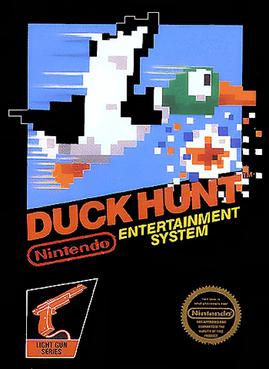
Duck Hunt is a 1984 light gun shooter video game developed and published by Nintendo for the Nintendo Entertainment System (NES). The game was first released in April 1984 in Japan for the Family Computer (Famicom) console and in North America as an arcade game for the Nintendo VS. System. It became a launch game for the NES in North America in October 1985, and was re-released in Europe two years later.
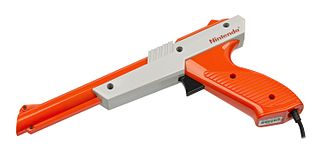
A light gun is a pointing device for computers and a control device for arcade and video games, typically shaped to resemble a pistol.

A game controller, gaming controller, or simply controller, is an input device or input/output device used with video games or entertainment systems to provide input to a video game. Input devices that have been classified as game controllers include keyboards, mice, gamepads, and joysticks, as well as special purpose devices, such as steering wheels for driving games and light guns for shooting games. Controllers designs have evolved to include directional pads, multiple buttons, analog sticks, joysticks, motion detection, touch screens and a plethora of other features.

The Zapper is an electronic light gun accessory launched within the Nintendo Entertainment System (NES) in North America on October 18, 1985. It is a cosmetic redesign by Nintendo of America's head designer Lance Barr, based on Gunpei Yokoi's Video Shooting Series light gun (光線銃シリーズガン), which had been released in Japan for the Famicom on February 18, 1984. The Zapper requires compatible NES games, such as Duck Hunt, Wild Gunman, and Hogan's Alley. Its internal optical sensor allows the player to aim at a television set and accurately shoot at in-game targets.
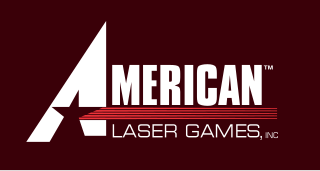
American Laser Games was a company based in Albuquerque, New Mexico that created numerous light gun laserdisc video games featuring live action full motion video. The company was founded in the late 1980s by Robert Grebe, who had originally created a system to train police officers under the company name ICAT and later adapted the technology for arcade games. Its first hit game was Mad Dog McCree, a light gun shooter set in the American Old West. By mid-1995 they were recognized as the leading company in the medium of laserdisc-based arcade games. Almost all arcade games released by the company were light gun shooters and a number of them also had an Old West theme.

The Menacer is a light gun peripheral released by Sega in 1992 for its Sega Genesis and Sega CD video game consoles. It was created in response to Nintendo's Super Scope and as Sega's successor to the Master System Light Phaser. The gun is built from three detachable parts, and communicates with the television via an infrared sensor. The Menacer was announced at the May 1992 Consumer Electronics Show in Chicago and was released later that year. The gun was bundled with a pack-in six-game cartridge of mostly shooting gallery games. Sega also released a Menacer bundle with Terminator 2: The Arcade Game.
The Gamegun is the only light gun released for the 3DO video game console. It was released in 1994 by American Laser Games, developers of full motion video-based shooter games. The Gamegun is styled exactly like the Peacekeeper Revolver, a light gun for the CD-i also released by American Laser Games, except with a notable color difference. The peripheral came in two versions: one player and two-player. The only difference between the two is that the two-player version, which was released in 1995, came with an attached y-connector end, allowing two players to plug in two light guns to play simultaneously. With the one player version, the gun could be daisy chained with a regular 3DO controller, allowing another player to use the gamepad at the same time.
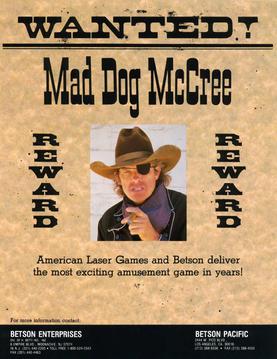
Mad Dog McCree is the first live-action laserdisc video game released by American Laser Games. It originally appeared as an arcade game in 1990.
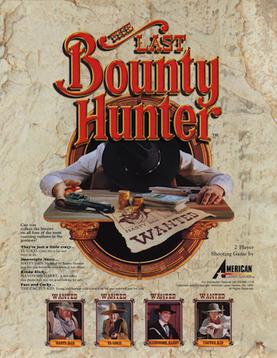
The Last Bounty Hunter is a live-action laserdisc video game released by American Laser Games in 1994. Like almost all of the games produced by the now-defunct company, it is a rail shooter and, like the two installments in the Mad Dog McCree series before it, is set in the Old West. However, it takes a more comedic approach than the Mad Dog McCree games in both its story sequences and the characters' comically exaggerated reactions to being shot. Filmed at Old Tucson Studios in Tucson, Arizona, it was one of the company's last releases before it was forced to close down. It was re-released by Digital Leisure in 2002 and was eventually packaged with Fast Draw Showdown by Global VR as an arcade cabinet under the name Six Gun Select.

Mad Dog II: The Lost Gold is a live-action laserdisc video game produced by American Laser Games, released for the arcade, Sega CD, 3DO, CD-i and DOS, the first release being in 1992; the quality of the video is the lowest on Sega CD. A sequel to the moderately popular Mad Dog McCree, the game abandoned the rather simple style of the original, introducing elements that can be considered "Hollywood", including dynamic shootout scenes and in-game music, as opposed to the original's almost complete lack thereof. Like the first game, the player follows the storyline and is required to quickly shoot certain enemies to proceed on the quest. The game was re-released by Digital Leisure in 2003 on DVD-Video and again in 2009 on the Wii as part of the Mad Dog McCree Gunslinger Pack, a compilation that also includes the first Mad Dog game as well as The Last Bounty Hunter.
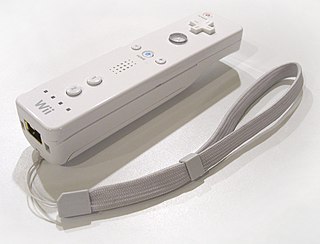
The Wii Remote, informally referred to with the portmanteau Wiimote, is the primary game controller for Nintendo's Wii home video game console. An essential capability of the Wii Remote is its motion sensing capability, which allows the user to interact with and manipulate items on screen via motion sensing, gesture recognition, and pointing using an accelerometer and optical sensor technology. It is expandable by adding attachments. The attachment bundled with the Wii console is the Nunchuk, which complements the Wii Remote by providing functions similar to those in gamepad controllers. Some other attachments include the Classic Controller, Wii Zapper, and the Wii Wheel, which was originally released with the racing game, Mario Kart Wii.
Digital Leisure, Inc. is a Canadian publisher of software. The company formed in 1997 with the aim to acquire, remaster and publish numerous classic video-based arcade games such as the Don Bluth-animated titles Dragon's Lair, Dragon's Lair II: Time Warp and Space Ace. Over time, they have acquired the publishing rights to various full motion video games, which they have re-released on a variety of modern formats. In more recent years, they have produced original games as well.

Crime Patrol 2: Drug Wars is a live-action laserdisc video game, released by American Laser Games in 1993. It was ported to the 3DO Interactive Multiplayer and CD-i. It is the sequel to the arcade game Crime Patrol, with very similar gameplay, objectives and scenery. The game was re-released by Digital Leisure in 2002.
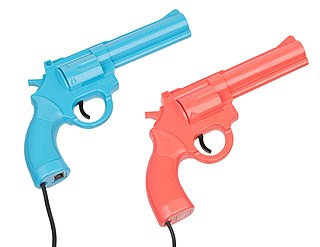
The Justifier is a light gun peripheral released by Konami for numerous home console games. Konami released versions of the gun for the Mega Drive/Genesis, Super NES, and PlayStation consoles. The original gun appeared similar to a Colt Python. The guns were originally designed for use with the home versions of Konami's Lethal Enforcers games, although they are also compatible with other titles.

The Wii Zapper is a gun shell peripheral for the Wii Remote. The name is a reference to and successor of the NES Zapper light gun for the Nintendo Entertainment System. It is mainly used to enhance controls for shooter games, including light gun shooters, first-person shooters, and third-person shooters.
Nintendo 64 accessories are first-party Nintendo hardware—and third-party hardware, licensed and unlicensed. Nintendo's first-party accessories are mainly transformative system expansions: the 64DD Internet multimedia platform, with a floppy drive, video capture and editor, game building setup, web browser, and online service; the controller plus its own expansions for storage and rumble feedback; and the RAM-boosting Expansion Pak for big improvements in graphics and gameplay. Third-party accessories include the essential game developer tools built by SGI and SN Systems on Nintendo's behalf, an unlicensed SharkWire online service, and unlicensed cheaper counterparts to first-party items. In the fifth generation of video game consoles, the Nintendo 64 had a market lifespan from 1996 to 2002.
Light-gun shooter, also called light-gun game or simply gun game, is a shooter video game genre in which the primary design element is to simulate a shooting gallery by having the player aiming and discharging a gun-shaped controller at a screen. Light-gun shooters revolve around the protagonist shooting virtual targets, either antagonists or inanimate objects, and generally feature action or horror themes and some may employ a humorous, parodic treatment of these conventions. These games typically feature "on-rails" movement, which gives the player control only over aiming; the protagonist's other movements are determined by the game. Games featuring this device are sometimes termed "rail shooters", though this term is also applied to games of other genres in which "on-rails" movement is a feature. Some, particularly later, games give the player greater control over movement and in still others the protagonist does not move at all. On home computer conversions of light-gun shooters, mouse has been often an optional or non-optional replacement for a light gun.
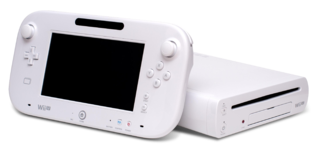
The Wii U is a home video game console developed by Nintendo as the successor to the Wii. Released in late 2012, it is the first eighth-generation video game console and competed with Microsoft's Xbox One and Sony's PlayStation 4.

Majesco Entertainment Company is an American video game publisher and distributor based in Hazlet, New Jersey. The company was founded as Majesco Sales in Edison, New Jersey in 1986, and was a privately held company until acquiring operation-less company ConnectivCorp in a reverse merger takeover, becoming its subsidiary and thus a public company on December 5, 2003. ConnectivCorp later changed its name to Majesco Holdings Inc. on April 13, 2004.














